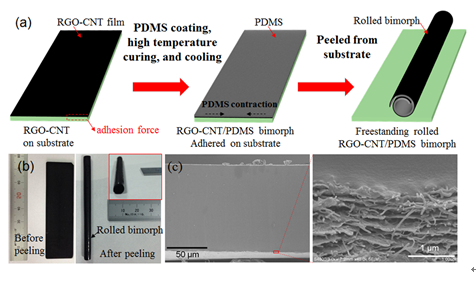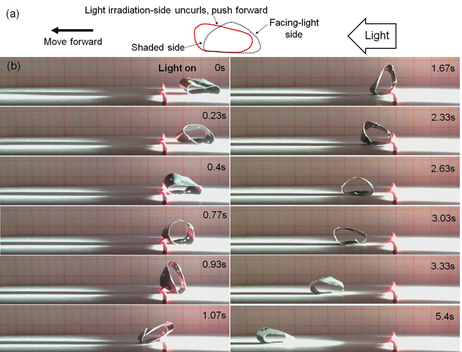Photoactuators can convert light stimuli into mechanical response, and possess unique advantages including wireless actuation, remote control, and abundant light source especially from the endless sunlight. For the fulfillment of their wide applications ranging from biomimetic robotics, artificial muscles, switches, to solar sail in space, significant efforts have been focused on the design of photoactuators with fast response, large deformation, and controllable motion. Recently, carbon-based nanomaterials, such as graphene, and carbon nanotubes (CNTs), are considered as promising candidates for the actuators, due to their excellent optical, thermal, mechanical and electrical properties. Various photoactuators with fast response based on graphene or CNT have been reported, showing their potential for the construction of high performance photoactuators.
Recently, Prof. CHEN Wei's group, at Suzhou Institue of Nano-tech and Nano-bionics, Chinese Academy of Sciences has new research progress on the high performance graphene-based photoactuator devices. They introduce reduced graphene oxide (RGO)-CNT/PDMS bimorph photoactuators which show large, fast and reversible light induced actuation and could lead to multiform motion output through configuration design. This rolled RGO-CNT/PDMS bimorph with tubular shape is formed by high temperature curing induced thermal stress (figure 1), and has the pseudo-shape memory feature which could provide the foundation for the construction of photoactuators. By taking the advantages of RGO and CNT, including excellent photothermal properties, good interfacial contact, and high thermal conduction, the rolled bimorph exhibits reversible actuation from closed loop to flat state with deformation as large as 479°under the simulated sunlight irradiation for only 3.6s. Based on this bimorph photoactuator, they further construct a series of light driven devices, including smart “roller blinds” to automatically open and block the strong light incident (figure 2a), smart “box” to unfold and let light in with the light on and to fold with the light off (figure 2b-2c), and the crawler-type “robot’ mimicking the movement of tank to fast move, cross the obstacles, and climb the steps (figure 3). These results reveal the potential application of the smart bimorph photoactuator in various fields, such as self-deployable sun sail in space for energy harvesting, smart curtain, sunlight driven biomimetic robot, and protective cover for the solar energy devices. This work was recently published in Advanced Materials (Advanced Materials, 2015, 27, 7867).
This work was supported by the Natural Science Foundation for Distinguished Young Scientists of Jiangsu Province (BK2012008), the Hong Kong, Macao and Taiwan Science & Technology Cooperation Program of China (2012DFH50120), the National Natural Science Foundation of China (11204350, 21373263), the Natural Science Foundation of Jiangsu Province (BK20131173), and the External Cooperation Program of BIC, Chinese Academy of Science (121E32KYSB20130009).

Figure 1. Rolled graphene-based bimorph photoactuator.(Image by CHEN Wei's group)

Figure 2. (a) light-controlled roller shutter, (b-c) Smart box.(Image by CHEN Wei's group)

Figure 3. Light-induced crawler-type robot based on graphene photoactuator.(Image by CHEN Wei's group)

